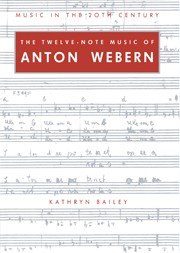Book contents
Summary
From the outset, the twelve–note technique was perceived as an inherently polyphonic method. Schoenberg, Berg and Webern were all willing – indeed, dedicated – inheritors of the German/Austrian musical tradition, a tradition based on the study of strict counterpoint; and all three, both before and after adopting the new method, wrote music that was essentially polyphonic. Webern's realization of the contrapuntal possibilities offered by the twelve–note technique was, however, very different from his colleagues'. Whereas the counterpoint of Schoenberg and Berg seems to spring from the free development of motives characteristic of the nineteenth century, Webern looked to pre–baroque contrapuntal procedures, which he incorporated with great exactness and discipline. That he should be drawn to venerable methods may be seen as predictable, in view of his studies in musicology and especially in the music of Isaac, studies that must have left him with a more extensive knowledge of the earlier style than his colleagues possessed. However, I think one must also see this turn to late medieval procedures for inspiration as evidence of his recognition of a basic affinity between the two styles, to both of which order is central.
It is generally recognized that Webern's twelve–note music is not only polyphonic but, more specifically, canonic. George Perle remarked in 1971 on Webern's inclination to employ canon at critical points in his development. His last non–dodecaphonic work, Op. 16, written in 1923–4, was a set of five canons on Latin liturgical texts for soprano, clarinet and bass clarinet.
- Type
- Chapter
- Information
- The Twelve-Note Music of Anton WebernOld Forms in a New Language, pp. 94 - 146Publisher: Cambridge University PressPrint publication year: 1991

